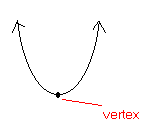
Graphing Parabolas
About now, some of you may be wondering, what's a parabola?
A parabola is: a
graph of a quadratic equation (function) in the form
y (or f(x) in a function, but I am using y) = ax2 + bx + c,
where the domain for x is all real numbers, and a ≠
0.
A domain is the replacement set for the variable in question.
Now a parabola will look like a U, either right-side-up or upside-down. Although it is curved, there will be a vertex. This is going to be either the minimum point, or the maximum one.
This is an example:

Since you have solved quadratic equations before, you know that when you solve for x (and y = 0), you get two real number solutions, no real number solutions, or one real number solution. The solutions to that equation are the x-intercepts of the equation's graph (because y = 0). If you changed y from 0 to other things, you would eventually get infinitely many two x-coordinate points, and just one one x-coordinate point (the vertex, because the x coordinates are the SAME). If you got one solution, consider yourself lucky, because you already found the vertex. For any other value of y besides that of the vertex, you will have 0 or 2 solutions.
For an example, let's find the x-intercepts of y = x2
+ 4x - 5
Solution: Set y equal to 0, to find the
x-intercepts. Now you have x2 + 4x - 5 = 0. The
trinomial can be factored into (x + 5)(x - 1). Therefore the solutions are
x = -5 and 1. This are the x-intercepts.
However, one goes about doing this slightly differently when
graphing a quadratic equation than when solving one. It is actually
easier. The x-coordinate of the vertex is going to be the average
of two x-coordinates with the same y-coordinate, because the U is
symmetrical, with the line of symmetry being the line with the x-coordinate of
the vertex. Find the x-coordinate of the vertex of the equation above.
(-5 + 1)/2 = -4/2 = -2
Now that we have the x-coordinate, we have to find y. To
do this, substitute the value you got for x into the equation to get y. So
now find y, and then list your vertex's coordinates.
(-2)2 + 4(-2) - 5 = y
4 - 8 - 5 = y
-9 = y
(-2, -9)
But we don't always want to do that rigorous work to find the vertex, nor the x-coordinates of any other point. So the formula to find the vertex of a quadratic equation is: -b/2a
Why? Because of this:
Take one of the most basic forms of a quadratic equation.
ax2 + bx = 0
x(ax + b) = 0
x = 0 or ax + b = 0
x = 0 or x = -b/a
The two x intercepts are 0 and -b/a.
Find the average of them: (0 + -b/a)/2 = (-b/a)/2 = -b/2a
Isn't it cool how it all works? ☺
Once you've found that, just find the y-coordinate the way we
did before.
So you can find the vertex of a quadratic equation. So what? Can you
graph the rest? Go to the next page to learn how.
Click
here to go to the next page of graphing parabolas.
Click here
to go to sketching parabolas.
Click here to go back
to the index.